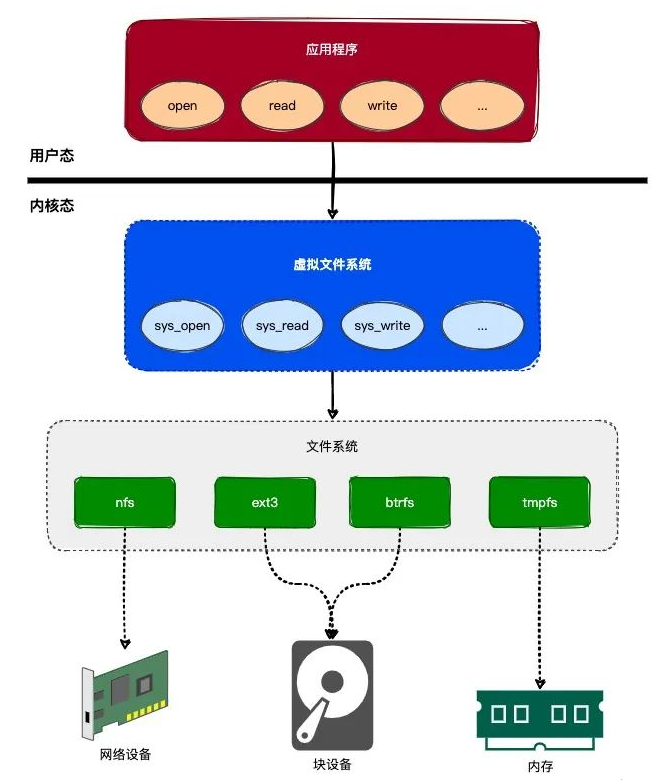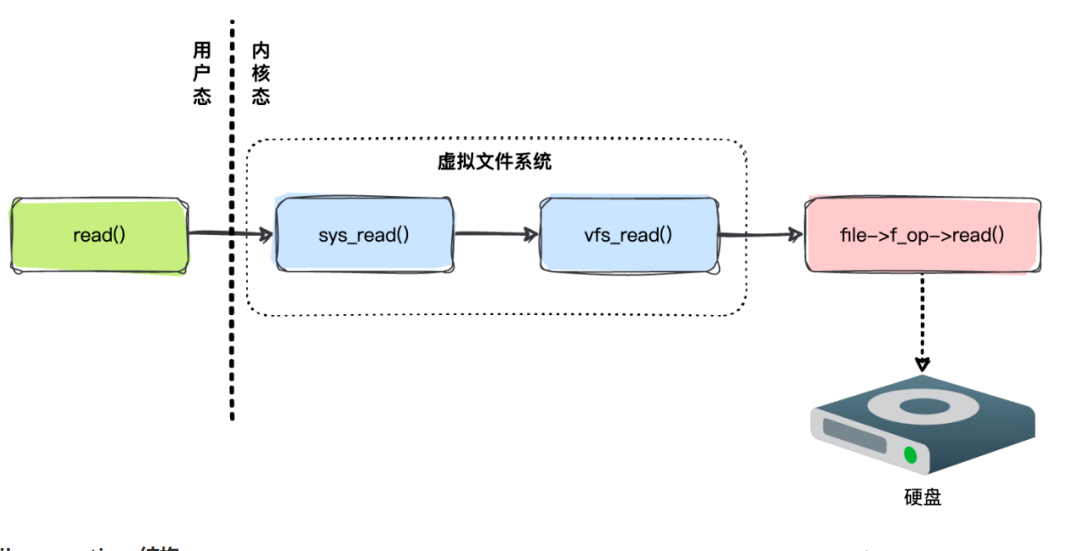
In the world of Unix, there is a classic saying: everything is a file. What this means is that in the Unix operating system, all objects can be treated as files, and they can be manipulated using the interface for operating files. As a Unix-like operating system, Linux also strives to achieve this goal.
In order to achieve the goal of Everything is a file, the Linux kernel provides an intermediate layer: Virtual File System (Virtual File System).
If you have ever used an object-oriented programming language (such as C/Java, etc.), then you should be familiar with the concept of Interface. The virtual file system is similar to the interface in object-oriented programming, which defines a set of standard interfaces. Developers only need to implement this set of interfaces, and then they can use the interface for operating files to operate objects. As shown below:

The blue part in the above picture is the location of the virtual file system.
As can be seen from the above figure, the virtual file system provides a unified interface for upper-layer applications. If a file system implements the virtual file system interface, then the upper-layer application can use functions such as open(), read() and write() etc. functions to operate them.
Today, we will introduce the principle and implementation of virtual file system.
Before explaining the principles of virtual file systems, let us first introduce a Java example. Through this Java example, we can more easily understand the principles of virtual file systems.
If you have used Java to write programs, it is easy to understand the virtual file system. We use Java's interface to simulate the definition of a virtual file system:
public interface VFSFile {
int open(String file, int mode);
int read(int fd, byte[] buffer, int size);
int write(int fd, byte[] buffer, int size);
...
}
The above defines an interface named VFSFile, which defines some methods, such as open(), read() and write() etc. Now we define an object named Ext3File to implement this interface:
public class Ext3File implements VFSFile {
@Override
public int open(String file, int mode) {
...
}
@Override
public int read(int fd, byte[] buffer, int size) {
...
}
@Override
public int write(int fd, byte[] buffer, int size) {
...
}
...
}
Now we can use the VFSFile interface to operate the Ext3File object, as follows:
public class Main() {
public static void main(String[] args) {
VFSFile file = new Ext3File();
int fd = file.open("/tmp/file.txt", 0);
...
}
}
从上面的例子可以看出,底层对象只需要实现 VFSFile 接口,就可以使用 VFSFile 接口相关的方法来操作对象,用户完全不需要了解底层对象的实现过程。
上面的 Java 例子已经大概说明虚拟文件系统的原理,但由于 Linux 是使用 C 语言来编写的,而 C 语言并没有接口这个概念。所以,Linux 内核使用了一些技巧来模拟接口这个概念。
下面来介绍一下 Linux 内核是如何实现的。
为了模拟接口,Linux 内核定义了一个名为 file 的结构体,其定义如下:
struct file {
...
const struct file_operations *f_op;
...
};
在 file 结构中,最为重要的一个字段就是 f_op,其类型为 file_operations 结构。而 file_operations 结构是由一组函数指针组成,其定义如下:
struct file_operations {
...
loff_t (*llseek) (struct file *, loff_t, int);
ssize_t (*read) (struct file *, char __user *, size_t, loff_t *);
ssize_t (*write) (struct file *, const char __user *, size_t, loff_t *);
...
int (*open) (struct inode *, struct file *);
...
};
从 file_operations 结构的定义可以隐约看到接口的影子,所以可以猜想出,如果实现了 file_operations 结构中的方法,应该就能接入到虚拟文件系统中。
在 Linux 内核中,file 结构代表着一个被打开的文件。所以,只需要将 file 结构的 f_op 字段设置成不同文件系统实现好的方法集,那么就能够使用不同文件系统的功能。
这个过程在 __dentry_open() 函数中实现,如下所示:
static struct file *
__dentry_open(struct dentry *dentry,
struct vfsmount *mnt,
truct file *f,
int (*open)(struct inode *, struct file *),
const struct cred *cred)
{
...
inode = dentry->d_inode;
...
// 设置file结构的f_op字段为底层文件系统实现的方法集
f->f_op = fops_get(inode->i_fop);
...
return f;
}
设置好 file 结构的 f_op 字段后,虚拟文件系统就能够使用通用的接口来操作此文件了。调用过程如下:

底层文件系统需要实现虚拟文件系统的接口,才能被虚拟文件系统使用。也就是说,底层文件系统需要实现 file_operations 结构中的方法集。
一般底层文件系统会在其内部定义好 file_operations 结构,并且填充好其方法集中的函数指针。如 minix文件系统 就定义了一个名为 minix_file_operations 的 file_operations 结构。其定义如下:
// 文件:fs/minix/file.c
const struct file_operations minix_file_operations = {
.llseek = generic_file_llseek,
.read = do_sync_read,
.aio_read = generic_file_aio_read,
.write = do_sync_write,
.aio_write = generic_file_aio_write,
.mmap = generic_file_mmap,
.fsync = generic_file_fsync,
.splice_read = generic_file_splice_read,
};
也就是说,如果当前使用的是 minix 文件系统,当使用 read() 函数读取其文件的内容时,那么最终将会调用 do_sync_read() 函数来读取文件的内容。
到这里,虚拟文件系统的原理基本分析完毕,但还有两个非常重要的结构要介绍一下的:dentry 和 inode。
dentry 结构表示一个打开的目录项,当我们打开文件 /usr/local/lib/libc.so 文件时,内核会为文件路径中的每个目录创建一个 dentry 结构。如下图所示:

由于 /usr/local/lib/libc.so 和 /tmp/libc.so 指向同一个文件,所以它们都使用同一个 inode 对象。
inode 结构保存了文件的所有属性值,如文件的创建时间、文件所属用户和文件的大小等。其定义如下所示:
struct inode {
...
uid_t i_uid; // 文件所属用户
gid_t i_gid; // 文件所属组
...
struct timespec i_atime; // 最后访问时间
struct timespec i_mtime; // 最后修改时间
struct timespec i_ctime; // 文件创建时间
...
unsigned short i_bytes; // 文件大小
...
const struct file_operations *i_fop; // 文件操作方法集(用于设置file结构)
...
};
我们注意到 inode 结构有个类型为 file_operations 结构的字段 i_fop,这个字段保存了文件的操作方法集。当用户调用 open() 系统调用打开文件时,内核将会使用 inode 结构的 i_fop 字段赋值给 file 结构的 f_op 字段。我们再来重温下赋值过程:
static struct file *
__dentry_open(struct dentry *dentry,
struct vfsmount *mnt,
truct file *f,
int (*open)(struct inode *, struct file *),
const struct cred *cred)
{
...
// 文件对应的inode对象
inode = dentry->d_inode;
...
// 使用inode结构的i_fop字段赋值给file结构的f_op字段
f->f_op = fops_get(inode->i_fop);
...
return f;
}
本文主要介绍了 虚拟文件系统 的基本原理,从分析中可以发现,虚拟文件系统使用了类似于面向对象编程语言中的接口概念。正是有了 虚拟文件系统,Linux 才能支持各种各样的文件系统。
The above is the detailed content of Describe the principles of Linux virtual file system in detail. For more information, please follow other related articles on the PHP Chinese website!




